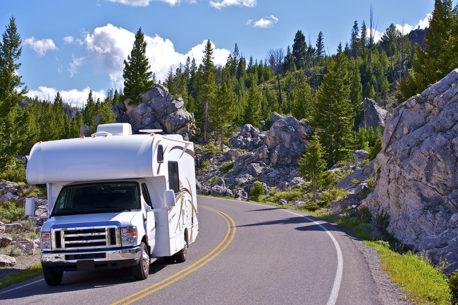The best part of owning an RV in the United States are the perfect camping locations around every corner of the country. From north to south, east to west, there’s a beautiful campground to visit and enjoy the great outdoors. But when it comes to planning the perfect trip, you can’t beat RV camping in national parks. With 59 national parks to visit, how do you choose where to start? Read our take on the best national parks for RV camping, plus a few bonus tips for planning your trip!
#1 Yosemite National Park, California
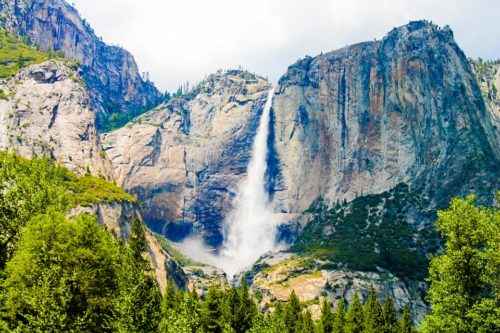
Renowned for its captivating waterfalls, beautiful meadows and unique rock formations, Yosemite National Park is one of the most popular national parks in the United States. With 1,200 square miles of deep valleys and vast wilderness, this national park was first protected in 1864 and should be high up on the list of places to visit for any RV camper.
RV camping at Yosemite National Park is easier than some parks, having 10 campgrounds with plenty of space for RVs and trailers. If you’re planning to visit during the busier season – March to October – make sure you get a campground reservation!
Yosemite National Park Must-See Attraction:
Glacier Point – One of the most memorable viewpoints in all of Yosemite. With a breathtaking view of Yosemite Valley, including Half Dome and three of the park’s waterfalls, Glacier Point is worth the hike!
#2 Yellowstone National Park, Wyoming

As the world’s first national park, millions of people come to see Yellowstone every year. The park contains half of the world’s known geysers, including its most popular attraction, Old Faithful. But that’s not the only reason to visit, Yellowstone also features a robust ecosystem that’s home to grizzly bears, wolves, and elk that draw sightseers from all over the world.
Making your RV campsite reservation at Yellowstone requires giving them the full length of your vehicle and any that are towed with it. If your plans change, make sure to contact the campground staff. If your equipment doesn’t match your reservation, the staff will have to turn you away. If you’re still shopping for an RV, Yellowstone has limited capacity for larger RVs; consider small RV living, which is a great option to make travel and camping easier!
Be prepared to do some sightseeing! You won’t want to hang around the campsite too much, considering the park is a massive 3,500 square miles and even stretches into parts of Montana and Idaho. Make sure you can stick around for at least a few days to give yourself ample opportunity to appreciate the grandeur.
Yellowstone National Park Must-See Attraction:
Old Faithful – As the main attraction of Yellowstone, your first trip to Yellowstone absolutely must include this awe-inspiring sight. Most eruptions happen in 90 minute intervals, making it easy to witness the spectacular event.
#3 Badlands National Park, South Dakota
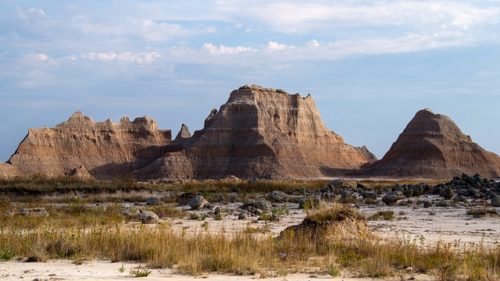
If you’re a stargazer, Badlands National Park is an experience that can’t be missed. This incredible expanse features everything you could want in a camping trip: beautiful landscape, unparalleled hiking, amazing natural history, and rare geological formations that you simply cannot find anywhere else. It’s no surprise that the Badlands attract campers from all around the world. You’ll find some of the world’s most abundant fossil beds in these 242,000 acres, an area that was home to the saber-toothed tiger.
Both available campgrounds are open year-round for RV camping, and you can stay up to 14 days at a time. For those that want to truly experience this park, the Sage Creek Campground is free of charge and offers an authentic, primitive experience. It’s likely that you’ll even get to see bison up close and personal, as they tend to wander through the grounds.
Badlands National Park Must-See Attraction:
The Wall – Right in the heart of the Badlands, the Wall is a heavily-eroded ridge that stretches 60 miles long. With beautiful rock formations exposed through erosion, the Wall is constantly changing, so even Badlands veterans find time to appreciate its splendor every visit.
#4 Acadia National Park, Maine

When it comes to RV camping in national parks, few locations offer as much diversity as Acadia. With mountains, lakes, shorelines and woodlands, this nearly 50,000-acre reserve offers a rich variety for the millions that visit each year. Acadia is the oldest national park in the eastern United States. Home to nearly 2,000 species of mammals, birds, aquatic wildlife and plants, Acadia is a favorite for hiking, fishing and camping.
When choosing a campsite, you’ll have your pick between woodland camping or a waterfront setting, with the Seawall waterfront campground available from late May to September. Acadia is very popular during the spring and summer months due to its cooler temperatures, so plan to make reservations for your trip! It’s recommended to travel on foot, bike, or using the shuttle. Once you’re setup in the campground, you can leave your RV until it’s time to hit the hay.
Acadia National Park Must-See Attraction:
Cadillac Mountain – At 1,530 feet, this mountain is the highest point on the northeastern coast. If you happen to visit between October and March, it’s also the first place that will see the sunrise each morning. But at any time of year, it offers an unforgettable view.
#5 Grand Teton National Park, Wyoming
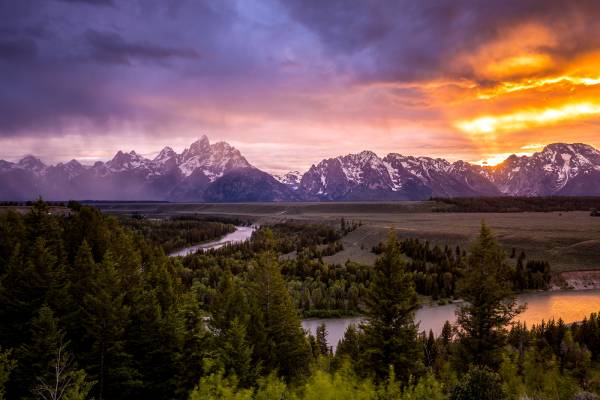
Grand Teton National Park is a United States National Park located in the U.S. state of Wyoming, south of Yellowstone National Park, on the border with Idaho. The park borders the Jackson Hole valley and contains the highest point in the state of Wyoming at 12,276 feet (3,713.4 m).
The park contains a variety of environments from alpine tundra to forests to the shoreline of Jackson Lake. The park is a haven for outdoor recreation, including hiking, fishing and boating. Grand Teton National Park is named after Grand Teton, the tallest mountain in the Teton Range, which rises more than 13,000 feet (4,000 m) above the valley floor. The naming of “Grand Teton” originated in 1875 when Col. John Wesley Powell named it “Jackson’s Teton” after a member of his expedition and future president, Andrew Jackson. The name was later shortened to “Teton” and retained its current designation of Grand Teton National Park.
#6 Crater Lake National Park, Oregon
Located in southern Oregon and formed when a volcano erupted and collapsed. The lake is 1,943 feet deep, the deepest lake in the United States. The rocks of the lake are filled with minerals and have a light blue color when they come into contact with the water, creating an unusually deep blue color that’s absolutely awe-inspiring.
The park is a popular destination for hikers, campers, photographers and photographers, with over 30 miles of hiking trails and a number of campgrounds located throughout the lands. This is the perfect park for RV travel because the campgrounds are spread out, the weather is mild and there are several different areas to explore.
Crater Lake National Park Must See Attraction: Wizard Island
The lake is also known for the Wizard Island, which is a volcanic cone which rises about 300 feet above the lake surface. You can access Wizard Island via boat, but only during the summer months when the boat tours are in operation, so plan accordingly!
#7 Everglades National Park, Florida
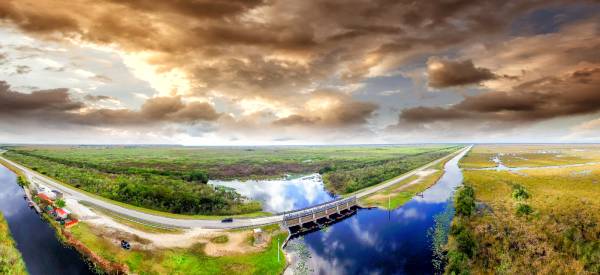
The Everglades National Park is located in southern Florida, in a subtropical environment near the shores of Lake Okeechobee. It’s the third largest national park in the lower 48 states and one of the few parks that offers a wide variety of activities in the wilderness. Though the Everglades National Park is man-made, it’s still a great place to explore.
It’s home to many endangered species, including the Florida panther, the American crocodile, the West Indian manatee, the American alligator, and the eastern indigo snake. Some of the most common animals spotted in the park include otters, raccoons, white-tailed deer, and ducks.
This beautiful park is home to many different ecosystems, including mangrove forests, coastal beaches, tropical hardwood hammocks, and coastal prairies
Tips for RV Camping at National Parks
- If you’re 62 years or older, you can apply for a $10 lifetime pass for every US National Park.
- Always plan to make reservations. If reservations aren’t available, make sure to get there early. Campsites are first-come, first-serve!
- Know the size of your RV and trailer, including your height and clearance levels and do a little research. Larger RVs can sometimes be difficult to bring to some national parks.
- Research any necessary permits before you go, for activities like fishing or boating.
- Remember the most important rule: always respect the land, wildlife, and other campers wherever you go!
Download the National Parks Quick Facts Sheet!
Contact RV Wholesale Superstore
If you’re looking for the perfect RV for a national parks tour, the professionals at RV Wholesale Superstore can find the model that’s perfect for you! Visit us in-person at 5080 W. Alexis Road, in Sylvania, OH or call us at (844) 601-1171
Connect with us on Social Media!
Facebook | Twitter | YouTube | Pinterest | Google+

